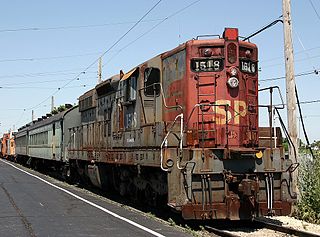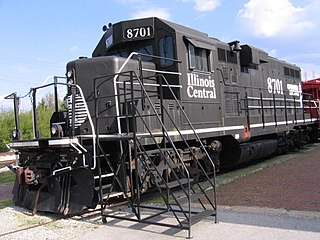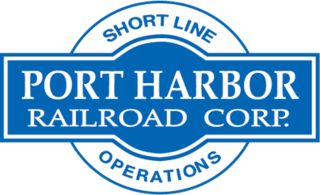
The Alaska Railroad is a Class II railroad that operates freight and passenger trains in the state of Alaska. The railroad's mainline runs between Seward on the southern coast and Fairbanks, near the center of the state. It passes through Anchorage and Denali National Park, to which 17% of visitors travel by train.

The EMD BL2 is a model of diesel-electric locomotive built by General Motors Electro-Motive Division (EMD). A total of 58 units were built between 1947 and 1949. The BL2 was not very successful, as it was unreliable and occupied a gap between carbody and hood units, which resulted in it suffering from the drawbacks of both designs. However, lessons learned from the BL2 were incorporated into EMD's next design, the GP7.

The ALCO RS-3 is a 1,600 hp (1.2 MW), B-B diesel-electric locomotive manufactured from May 1950 to August 1956 by American Locomotive Company (ALCO) and its subsidiary Montreal Locomotive Works (MLW). A total of 1,418 were produced: 1,265 for American railroads, 98 for Canadian railroads, 48 for Brazilian railroads, and seven for Mexican railroads.

A hood unit, in North American railroad terminology, is a body style for diesel and electric locomotives where the body is less than full-width for most of its length and walkways are on the outside. In contrast, a cab unit has a full-width carbody for the length of the locomotive and walkways inside. A hood unit has sufficient visibility to be operated in both directions from a single cab. Also, the locomotive frame is the main load-bearing member, allowing the hood to be non-structural and easily opened or even removed for maintenance.

The EMD F7 is a model of 1,500-horsepower (1,100 kW) diesel-electric locomotive produced between February 1949 and December 1953 by the Electro-Motive Division of General Motors (EMD) and General Motors Diesel (GMD).

Electro-Motive Diesel is a brand of diesel-electric locomotives, locomotive products and diesel engines for the rail industry. Formerly a division of General Motors, EMD is now owned by Progress Rail Electro-Motive Diesel traces its roots to the Electro-Motive Engineering Corporation, founded in 1922 and purchased by General Motors in 1930. After purchase by GM, the company was known as GM's Electro-Motive Division. In 2005, GM sold EMD to Greenbriar Equity Group and Berkshire Partners, and in 2010, EMD was sold to Progress Rail. Upon the 2005 sale, the company was renamed to Electro-Motive Diesel.

The EMD GP7 is a four-axle (B-B) diesel-electric locomotive built by General Motors Electro-Motive Division and General Motors Diesel between October 1949 and May 1954.

The EMD GP9 is a four-axle diesel-electric locomotive built by General Motors' Electro-Motive Division between 1954 and 1959. The GP9 succeeded the GP7 as the second model of EMD's General Purpose (GP) line, incorporating a new sixteen-cylinder engine which generated 1,750 horsepower (1.30 MW). This locomotive type was offered both with and without control cabs; locomotives built without control cabs were called GP9B locomotives.

The SD7 is a model of 6-axle diesel locomotive built by General Motors Electro-Motive Division between May 1951 and November 1953. It had an EMD 567B 16-cylinder engine producing 1,500 horsepower (1.12 MW) for its six traction motors. United States railroads bought 188 units.

The EMD SD9 is a model of diesel locomotive built by General Motors Electro-Motive Division between January 1954 and June 1959. An EMD 567C 16-cylinder engine generated 1,750 horsepower (1.30 MW). Externally similar to its predecessor, the SD7, the SD9 was built with the improved and much more maintainable 567C engine.

The EMD SD40 is an American 6-axle diesel-electric locomotive built by General Motors Electro-Motive Division between January 1966 and August 1972. 1,268 locomotives were built between 1966 and 1972. In 1972, an improved version with new electronics was developed and marketed as a new locomotive, the SD40-2.

The SD45 is a six-axle diesel-electric locomotive class built by General Motors Electro-Motive Division between 1965 and 1971. It has an EMD 645E3 twenty-cylinder engine generating 3,600 hp (2,680 kW) on the same frame as the SD38, SD39, SD40, and SDP40. As of 2023, most SD45s have been retired, scrapped or rebuilt to SD40-2 standards.

The "Beep" is an individual switcher locomotive built in 1970 by the Atchison, Topeka and Santa Fe Railway at its Cleburne, Texas, workshops. Technically a rebuild, the Beep originally entered service on the Santa Fe as a Baldwin Model VO-1000. Following its successful CF7 capital rebuilding program, the company hoped to determine if remanufacturing its aging, non-EMD end cab switchers by fitting them with new EMD prime movers was an economically viable proposition. The conversion procedure proved too costly and only the one unit was modified. In 2008-2009, this locomotive was retired and stored operational at Topeka, Kansas. In May 2009 the unit was donated to the Western America Railroad Museum in Barstow, California.

The EMD GP16 are a series of rebuilt diesel-electric locomotives, a result of a remanufacturing program initiated by the Seaboard Coast Line Railroad (SCL) in an effort to spare the cost of purchasing new motive power in the late 1970s. This involved the rebuilding of their aging fleet of EMD GP7, GP9 and GP18 road switchers. 155 locomotives were rebuilt by the SCL.

The Butte, Anaconda and Pacific Railway is a short line railroad in the U.S. state of Montana. The BA&P was founded in 1891 and operated as such until sale in 1985, when it was renamed the Rarus Railway. The railway was again sold in May 2007 to the Patriot Rail Corporation, and the name returned to the Butte, Anaconda and Pacific Railway in July 2007. The railway was the main conduit for ore transport between Butte and Anaconda, and was used for filming of portions of the 1985 Golden Globe nominated movie Runaway Train.

The EMD GP10 is a diesel-electric locomotive that is the result of rebuilding a GP7, GP9 or GP18.

The EMD GP49 is a 4-axle diesel locomotive built by General Motors Electro-Motive Division. Power was provided by an EMD 645F3B 12-cylinder engine which generated 2,800 horsepower (2.09 MW). The GP49 was marketed as one of four models in the 50 series introduced in 1979. The 50 series includes GP/SD49 and GP/SD50. Both the GP and SD50 were relatively popular with a total of 278 GP50s and 427 SD50s built. The SD49 was advertised but never built and a total of nine GP49s were built.

The EMD GP11 is a four-axle diesel locomotive rebuilt by the Illinois Central Railroad's Paducah shops. It is very similar in appearance to the GP8 and GP10.

The Port Harbor Railroad is a short-line railroad in Granite City, Illinois, serving an industrial port district known as America's Central Port. PHRR began operations in 2004 as a subsidiary of the Respondek Railroad and connects with the Terminal Railroad Association of St. Louis at "WR Tower," a major railroad junction in Granite City. PHRR transports everything from steel and aluminum products to foods, lumber, paper, chemicals, minerals, grains and other products. The railroad is classified as a Class III Common Carrier.



















